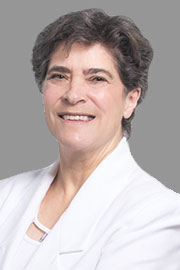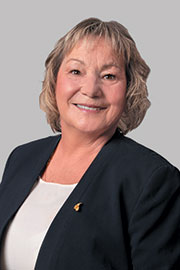- Sep/28/23 1:50:00 p.m.
- Re: Bill 131
I’d like to thank my colleague the member for Hamilton Centre for her powerful and insightful remarks based on sharing her personal experiences as someone who uses a wheelchair and tries to use transit, which often fails her.
My question is around the government’s Transit-Oriented Communities Program, which has been very, very short on details. There is certainly a cloak of secrecy that surrounds that program. In light of that, does the member feel confident in the government’s ability to ensure a transit system that actually meets the needs of all Ontarians, including Ontarians with disabilities?
- Hear!
- Rabble!
- Sep/28/23 1:50:00 p.m.
- Re: Bill 131
It depends on if the station itself is accessible. There are also issues in the station that have created difficulties for people to navigate, including how things are labelled and just people’s ability to get around in the actual station.
So, yes, in some ways, having more stations could help with accessibility, but unless this government actually commits to building an accessible Ontario by 2025 and meeting its real targets, more of the same problem isn’t going to fix the underlying accessibility issues.
We really do need to fix the subway system, because it’s not clear where to enter for people in wheelchairs or walkers, or who struggle to get around, and when construction is added into that, it’s just really unsafe.
And then continuously saying these solutions are going to help people who are struggling with housing, when I’m seeing the opposite—these failed transit projects, over and over again, whether it’s the Eglinton Crosstown or the Hamilton LRT, are actually making people’s housing issues worse, in my opinion.
I think we need to go back to the table and think about how we’re going to make our current transit systems accessible, rather than continuing to introduce shiny new projects that often continue to fail.
I just don’t see a way forward that shows me that this government is prioritizing disabled people when we do talk about transit.
- Hear!
- Rabble!
- Sep/28/23 1:50:00 p.m.
- Re: Bill 131
Thank you to the member opposite. Madam Speaker, I heard the members opposite speak about investments in rural Ontario. There’s no government in the history of Ontario that has made more investments in rural Ontario. Not only are we investing $184 billion in infrastructure over the next 10 years, we’re making unprecedented investments in transit.
My question to the member opposite is, will the member opposite vote in favour of this bill and support the people of Ontario?
- Hear!
- Rabble!
- Sep/28/23 1:50:00 p.m.
- Re: Bill 131
Thank you, Speaker, and good afternoon.
Interjections.
It’s a pleasure to join the debate on Bill 131, the Transportation for the Future Act, 2023.
Speaker, when you step back and you read the bill—it’s not a long bill to read, as you know—there are some key aspects in it. One of the underpinning aspects is that it delivers on our plan to build a stronger Ontario, doesn’t it? It does. The proposed legislation, if passed, will improve transit service and convenience and help the province and municipalities like Whitby, Pickering, Ajax, Oshawa and eventually Bowmanville to build transit-oriented communities along the GO rail system, going east and west, allowing for more homes, affordable housing options, parkland, retail and office space near transit.
Speaker, the proposed legislation is a response to requests from the municipalities that I just referred to in the region of Durham and other upper-tier governments across the greater Toronto and Hamilton area for a new optional funding tool that will enable municipalities to raise revenues to build much-needed transit and housing. The new tool is called the station contribution fee. Speaker, it’s going to allow municipalities to fund and design the construction of new GO stations and recover the costs over time, as transit-oriented communities like Whitby, Oshawa, Clarington, Pickering and Ajax build around some of the future stations as we move further east, beyond Oshawa, going forward. What this will also do is help speed up the construction of new GO transit stations while also creating new opportunities for mixed-use communities around those stations.
That particular statement that I just made is a good segue into a statement that I received from the mayor of Clarington. You’ll remember that we’re going to go further east beyond Oshawa to Bowmanville. When the mayor read the news release related to Bill 131, he was prompted to provide this statement, in part from a news release that he posted on the Clarington website. Here’s what he had to say, Speaker:
“The planned extension of the province’s GO Transit network to Clarington will introduce significant economic and employment opportunities to the community. The faster the two stations planned for Clarington can be built, the quicker the GO train can come here, bringing better transit options for Clarington residents and a better quality of life. Regular GO Transit service has the potential to transform the Major Transit Station Areas ... in Bowmanville and Courtice. Clarington thanks the Ontario government for their determination to complete the GO Lakeshore East extension and strengthen the economic potential of Clarington and”—yes, Speaker, the region of Durham.
It’s not only Clarington that is pleased about the announcement on Bill 131. As you would expect, the region of Durham, which is the upper-tier government in Durham that’s comprised of eight municipalities—the announcement by the Honourable Kinga Surma about Bill 131 also initiated a response from the regional chair. This is what he had to say:
“This legislation brings Durham region one step closer to its vision of vibrant, livable and sustainable communities near new rapid transit stations. We applaud the province’s innovative approach to economic development, enabling new legislation to help make the four new stations along the GO Lakeshore East extension into Bowmanville a reality.”
That’s John Henry, the regional chair and chief executive officer for the region of Durham.
Speaker, the recent steps undertaken by the government—and this is an important step because it’s interrelated to the underlying principles of Bill 131—to extend GO Transit service to Bowmanville are a strong step forward in affecting this particular legislation, because every day, thousands of residents from east Durham can commute to work in or around the greater Toronto-Hamilton area.
Now, as communities continue to grow within the region of Durham, the need for more and better transportation options is clear. I see it every day commuting from Whitby into Queen’s Park. That’s why the Bowmanville GO extension will be a game-changer for residents along the Lakeshore East line, improving access to jobs, housing and local landmark destinations.
But, Speaker, there are many more benefits that I want to share with you and my colleagues here in the Legislative Assembly, and those are:
—moving people from their vehicles to public transit, thereby reducing congestion on the 401;
—enabling sustainable, walkable transit-oriented communities; and
—increasing the provision of housing, including affordable housing units.
Speaker, the extension of the Lakeshore GO Transit East is a signature project in the region’s post-pandemic recovery framework and action plan. I had the occasion last night to speak at the Ontario power corporation headquarters to an audience of about 325 people—entrepreneurs, but other representatives of the broader community across the region of Durham. Included in that group was the executive director of economic development for the region of Durham, and he was absolutely ecstatic that this particular legislation has been brought forward because it’s going to be the kick-start for the implementation of the recovery framework and action plan going forward.
Speaker, going forward, the extension will also support job growth, reduce traffic, connect students—and we’ve got two universities in the region of Durham: Ontario Tech, Trent Durham and, of course, Durham College, which is in my riding.
I want to take a moment, Speaker, at this juncture of my remarks—and I’m conscious of the remaining time that I have; it is 12 minutes, but there are some key points that I think are material in the discussion of this legislation and its relative impacts. I want to take a moment to explain how the proposed station contribution fee would work.
Key to me, Speaker, as a former member of the Durham regional council for seven years, and six years prior to that on the Whitby town council, is that it’s going to give municipalities—the eight municipalities within the region of Durham—the flexibility to determine what works best for them. Municipalities could recover the cost over time by levying a station contribution fee on development that gets built around a GO Transit station, like those presently located in Pickering and Ajax and Whitby and Oshawa.
The fee would be a voluntary tool—that’s another key point—for municipalities, and they would apply to the province to use it. It means that this legislation, if passed, would create a new and voluntary funding tool for municipalities that would help spur the construction of new GO Transit stations, accelerating transit expansion while building vibrant mixed-use communities and much-needed housing.
Speaker, station contribution fees will also facilitate earlier GO station construction by spreading the cost of delivering the stations across multiple developments and over multiple years, and new stations would also spur the development.
What’s clear to me, as I review the legislation, is that we know that our province, like many areas across the country, is facing a housing crisis. We also know that we’re experiencing the fastest population growth in years. As an example, in the region of Durham in the next two and half years, we’re going to have a million people—a million people in the region of Durham. Therefore, we need the necessary infrastructure to support this rapid growth, and that’s why we’ve introduced the Transportation for the Future Act that, if passed, would build more GO Transit stations, resulting in a more convenient commute across the greater Golden Horseshoe for hard-working families.
With the proposed legislation, we’re seizing a once-in-a-generation opportunity to build vibrant mixed-use communities around transit stations. That, Speaker, has been a feature of the official plans of the eight municipalities within the region of Durham and indeed the official plan that our upper-tier government has in the region of Durham.
Speaker, these transit-oriented communities also will bring more housing, jobs, retail, and public amenities close to transit, and once again that responds to what the Durham MPPs have been hearing from our communities for a long time. I’ve heard it as a representative both at the local level and regional level, and for the past eight years as an MPP, and so have the other MPPs in Durham.
I’ll move along here. Speaker, there are some examples of work that’s already under way. We’re working with partners to explore a transit-oriented community at the new Woodbine GO station in Etobicoke along Highway 27, and this proposed station will help residents in Etobicoke and surrounding areas connect to the GO line and get where they need to go, while serving as a future hub for economic development and jobs and increasing housing opportunities.
We’re also working on constructing key improvements to the existing Mimico GO station. If anyone has ever been on the GO train and you stop at Mimico, it’s long overdue, believe me. Now that’s happening, and that’s a good thing. That includes the new fully accessible main station building and the extension of a multi-use greenway path for pedestrians and cyclists to use to access that particular station. Another feature is that the transit-oriented community is expected to create more than 2,000 housing units, including affordable housing options, along with a retail plaza, a passenger pick-up and drop-off area, and enhanced station amenities including hundreds of new underground parking spaces and spaces for bike storage. It will transform the Mimico GO station and the surrounding area and, as I just pointed out, bring more housing as well.
Speaker, this legislation, if passed, will also impact transit service integration by enhanced cross-boundary transit service integration. This has been a long-standing request of upper-tier governments for five, six, seven years. We’ve listened, we’ve responded, and it’s happening. We’re doing that by matching routes with the ways people travel across the region. Local transit providers can plan and offer more convenient services for transit riders, and riders will be able to take the first bus available regardless of which transit agency provides that service. The proposed changes will also make it easier for people to take transit and help families. This is an important feature. We all want to spend more time with our families, don’t we? Well, what I’m talking about is going to affect that and also increase ridership at the same time. These changes will be a step towards a more integrated transit network.
Also, Speaker, the province will be working with municipal partners like the region of Durham to integrate transit services across the greater Golden Horseshoe and to create a plan to remove double fares across the transit system. In May of this year, following a broad consultation with municipalities, we launched debit payment across much of the Presto system—including GO Transit; UP Express; Brampton Transit; Burlington Transit; my home, Durham Region Transit; Hamilton Street Railway; MiWay, Oakville Transit; and York—allowing riders to get on board with just a tap of the debit card, including if it’s stored on a smart phone or smart watch. This upgrade marked another milestone for the Presto system, giving transit riders yet another convenient payment option when travelling for work, school, leisure and more and yet again—yet again—demonstrating our government’s commitment to making the transit experience easier for people in all of our communities across Ontario.
The launch of the credit and debit payment on GO and local transit agencies around the 905 serves as another example of making transit more convenient. Once again, by increasing transit payment options we gave more people more options to access public transit in ways that work for them. That’s an important characteristic, isn’t it? It’s a reflection of the level of consultation that took place before we proceeded along those lines.
Now with more people returning to public transit, our government was happy to provide municipalities with the funding they needed to accommodate more riders, because those riders are there. They’re getting onto the buses.
In February of this year we were pleased to provide more than $379 million to help municipalities operate and improve their local transit systems. That funding, Speaker, which was delivered through the provincial gas tax program, was used to extend service hours; buy transit vehicles, which occurred in my region; add routes; improve accessibility, which is key; and upgrade infrastructure.
To make up for reduced gas sales during the pandemic, we provided an additional $80 million to municipalities to ensure they could continue to support their transit systems as ridership began to increase. Throughout Ontario, 144 communities across 170 municipalities benefited from this funding, which helped them, in the process, deliver reliable service to riders at a time when ridership was booming after two years of slowdown.
This is just one more example of our commitment to working in co-operation with municipalities across the province to improve public transit. Again, I can’t stress enough the level of consultation that has occurred that brings us here this afternoon with this bill and the effect of this bill.
At a fundamental level, the City of Toronto Act amendments proposed in the bill are proof that our government is a collaborative government, a government that is willing to work with our municipal partners to get it done for the people of Ontario. The COTA amendments are a direct response to the city of Toronto’s request to run its transit system the way it sees fit, to better serve its residents and neighbours.
In sum, the proposed changes provide the city of Toronto with the tools to better integrate its transit services with other regional transit networks by allowing the TTC to enter into cross-boundary service agreements with neighbouring transit agencies. This is great news for commuters who, at the end of the day, don’t care what colour bus they’re getting on, they only care about getting from point A to B safely, quickly and affordably.
The fact that the Toronto city council has endorsed this particular approach is a good thing. It’s a good thing, but, again, it’s another example of the level of collaboration that has occurred.
Speaker, I’m going to wind up my remarks right now because I said at the outset that this particular bill and the content of it is underpinned by the key themes in the Ontario budget, Building Ontario. Two key aspects stand out for me: building key infrastructure projects faster, attracting more jobs and investment, but also getting more housing built and allowing more families and residents to spend more time with their families. That’s what this legislation does. It’s a responsible approach to help people today by laying a strong foundation for future generations.
Through the legislation our government is strengthening and connecting communities, expanding and integrating Ontario’s transit network, supporting economic growth, creating more jobs and housing and improving the lives of Ontarians for generations to come.
- Hear!
- Rabble!
- Sep/28/23 1:50:00 p.m.
- Re: Bill 131
Further questions?
Further debate? I recognize the member from Whitby.
- Hear!
- Rabble!
- Sep/28/23 1:50:00 p.m.
- Re: Bill 131
Thank you so much to the member for your remarks. I understand. I was on the board of the TTC about 10 years ago, and I saw these issues being discussed first-hand. No doubt, making the system accessible has taken way longer than it should, and it’s an ongoing, challenging project.
Building transit, as well, is challenging. So much of it is creating the substantive infrastructure around statements and whatnot. But I certainly acknowledge its impacts on the accessibility of the network.
My question, though, is: Our goal here is to, as the previous member questioned, integrate these transit systems more closely with housing, having transit-oriented communities so that you’re right next to the network. I guess my observation would be that I would think that would make it broadly more accessible, and I would appreciate your perspective on that goal of the legislation.
- Hear!
- Rabble!
- Sep/28/23 1:50:00 p.m.
- Re: Bill 131
I do want to thank the member for Hamilton Centre for her speech on Bill 131. I also think it’s so important to have people with diverse experiences come to this place and represent the people that they were elected to serve, and to put that lens on a piece of legislation like this. Certainly accessibility is a huge part of transportation—a lack of access to adequate transportation becomes a huge employment barrier for so many people across this province.
My question specifically, though, because she touched on the affordability: This new station contribution fee, which is essentially now a download to municipalities to pay for infrastructure—we know that municipalities are already struggling to pay for municipal infrastructure, especially after Bill 23. Now this government is signalling that municipalities will also need to pay for provincial infrastructure if they want transit any time soon. Do you believe that the city of Hamilton is in a position, given all of their cost pressures, to actually fund the development of GO stations?
- Hear!
- Rabble!
- Sep/28/23 1:50:00 p.m.
- Re: Bill 131
Thank you very much for talking to us, really, about the situation for people with disabilities on public transit. I was recently at Yonge and Bloor. I finally discovered the accessible entrance and the elevator. I stood there for 10 minutes and the elevator didn’t come. I saw somebody who really, really needed that elevator, and he’d been standing there for 10 minutes too. There was no signage at all saying it was out of service, and there were no directions as to where to go if the elevator wasn’t working.
I’m wondering if you could just talk a bit about how frequently that kind of situation comes up.
- Hear!
- Rabble!
- Sep/28/23 2:20:00 p.m.
- Re: Bill 131
Madam Speaker, I was listening to the member. What wonderful information he has provided. He, along with all of the other members, is supporting the communities at large.
What I want to know from the member: For his own riding, how will this bill impact, and what will be the benefit to, the residents you serve because of this bill?
- Hear!
- Rabble!
- Sep/28/23 2:20:00 p.m.
- Re: Bill 131
I was listening to the member from Whitby talk about all the GO stations that have already been built, and how great they are, how accessible they are and how bright, and opening. I have to say, those stations were built by the province. We have a long-standing tradition of supporting the stations and funding the rails in between, whereas right now this piece of legislation is going to introduce this new tool called the station contribution fee, which is essentially a download onto municipalities.
Actually, it was supposed to be Metrolinx that was going to do it. Metrolinx was going to negotiate deals in which developers would fund a new GO station in exchange for development rights. This government definitely has a problem now with developers, so they’ve moved away from that, and now the government evidently expects municipalities to assume funding responsibilities. In what world does this government think, with all of the cost pressures that are happening right now in the province of Ontario, that municipalities—like Kitchener, for instance, which doesn’t have a GO station; we have a Via station that’s sometimes open and sometimes closed.
How are they going to afford to build GO stations?
- Hear!
- Rabble!
- Sep/28/23 2:20:00 p.m.
- Re: Bill 131
Well, you see, this is what differs between the official opposition and the government: We listen to municipalities, Speaker. We listen.
The policy is voluntary. It’s absolutely voluntary. Without the SCFs, the ability to build, for example, upwards of 30,000 homes in my region, in Durham, would cease to exist. That’s the reality, right? It’s voluntary, and it allows municipalities to create new revenue streams solely for the purpose of funding GO station delivery costs where the market-driven approach is not feasible.
That’s where the difference is between the opposition—
There are other local attractions, for example, in Clarington, in Bowmanville, that many of the residents in Whitby want to access. While I have some agricultural communities in the north part of my riding, there are other features of agriculture that the residents in the town of Whitby want to access, that are more resident in Bowmanville—in the north part of Bowmanville, but further north as well. There are some farming communities that they want to participate—like Watson Farms, which is a multi-use farm, but it’s an opportunity for young people to learn about farming and the values of agriculture in our community going forward.
I thank my colleague for his great question.
I understand that some of the caucus members in the official opposition are predominantly from Toronto, but this particular bill speaks about—the purpose is to help build new stations, predominantly outside of Toronto, and we’ve done that, with wide and purposeful consultation with communities across the province of Ontario.
I’ll take us back to the effect of the station contribution fee in particular, because that particular fee, even though it’s an optional tool, allows municipalities to impose a fee on new residential and commercial development, as well. But out of my discussions with some members of Durham regional council, as well as some of the local-level councillors from the eight municipalities that comprise the region of Durham, this effect is going to be significant surrounding new GO stations. Municipalities are looking forward to this, applying innovative approaches to the actual construction of affordable housing units, but also commercial and residential as well.
But that question, the exact question—Speaker, through you—was asked to our minister the Honourable Kinga Surma, the Minister of Infrastructure, and I’m going to read her response, if I may, please, Speaker, because I think it’s material to the conversation this afternoon:
“I think that all of us in this House deeply express our gratitude to the front-line workers, the transit workers who kept transit going during one of the most difficult times....
“That being said, we are mindful and respectful of collective bargaining, which is why I think the intention of this bill that’s before us is really to work with the city, to work with the TTC, in order to look for ways in which we can make transit more convenient for riders—and,” importantly, Speaker, “respectful of the collective bargaining that is occurring.”
Thank you for the question.
- Hear!
- Rabble!
- Sep/28/23 2:20:00 p.m.
- Re: Bill 131
This is a bill that is relevant to southern Ontario, but doesn’t have anything to say about transit in northern Ontario. That’s the part of the province you see when you flip the map over.
Years ago, the Mulroney Conservative government killed passenger train transit to Thunder Bay. During the last few years, we lost—well, all communities lost—access to Greyhound bus transit. We went for months with no intercity transit at all, and now we have a patchwork of expensive bus services. Right now, it costs $350 to get from Geraldton to Thunder Bay—that’s about a three-hour drive—for a medical appointment, but the Northern Health Travel Grant only covers about half of that cost.
There are two parts to my question: (1) Will the government take the transportation needs of northerners seriously and reduce the costs of transit in northwestern Ontario? (2) Will the government increase the Northern Health Travel Grant so that northerners can afford to access health care when and where they need it?
- Hear!
- Rabble!
- Sep/28/23 2:20:00 p.m.
- Re: Bill 131
I really want to thank my friend our member from Whitby for his insightful remarks. I want to ask him, again, on the tremendous housing crisis that Ontario is faced with because of the tremendous immigration every week coming into our province—which is wonderful. But would the member agree that this is exactly why we need to move forward with this bill, because we want to have seamless integration of transit all throughout our province in order to build homes and to make sure that people who live in other municipalities can go seamlessly to work, to shop and to raise their children throughout Ontario?
- Hear!
- Rabble!
- Sep/28/23 2:20:00 p.m.
- Re: Bill 131
It’s always a pleasure to rise in this House to speak on behalf of the people of Parkdale–High Park. Today we are debating Bill 131, Transportation for the Future Act. I’ve got to say, when I read the title, I had to shake my head. This government is not building transportation for the future. This government is not building transportation for the future. This government is not even building transportation for the present.
Eglinton Crosstown is the biggest example right now: 12 years of construction, tens of thousands of people’s daily lives disrupted, over $13 billion already and we don’t know how much more. It’s a bottomless pit, and we still don’t know if the transit will ever run. So what future is this government talking about when we don’t know if, after everything related to Eglinton Crosstown, the transit will ever be built?
I know that this P3 contract for Eglinton Crosstown was signed by the Liberal government—big mistake on their part. But in 2018, when the Auditor General audited the Eglinton Crosstown, she said that there were numerous things that were going wrong and Metrolinx wasn’t doing their part to hold the Crosslinx consortium to account. Two years later—2020—the Auditor General did a follow up report and said that not only did everything that she raised not get addressed by this Conservative government; things were actually worse now.
The only thing that has actually happened since the Auditor General’s report was lawsuits and more payout from the public purse to the consortium. Now, we still have no credible plan, no timeline. It’s an indefinite delay. So this government, we can say confidently, Speaker, does not know how to build transit, does not know how to deliver on transit projects.
There are numerous issues with Metrolinx, and the previous transportation minister did not hold Metrolinx accountable. And it seems that the current Minister of Transportation is following in the same direction. The Metrolinx CEO is one of the highest-paid public servants—almost $900,000 a year in salary. Fifty-nine vice president positions at Metrolinx, 19 C-suite executives—all of whom seem to be unable to hold a P3 contractor to account.
Get this, Speaker: There’s no engineer at Metrolinx; it’s all consultants. The work is all farmed out. You have contractors hiring subcontractors. The whole structure is very opaque, I would say deliberately, because then it becomes very hard to hold somebody to account.
Metrolinx has forgotten that they are a public transit agency. Metrolinx has forgotten who they work for. Did the government learn from the Eglinton Crosstown fiasco? They blamed the Liberals, but then what do they go ahead and do? Award more P3 contractors for the Ontario Line project and award even bigger contracts. We’ve seen the same thing happen in Ottawa. It’s happening at Finch, at Eglinton. Why is this government continuing to go down the same path? They don’t seem to be learning the lessons, and they certainly don’t seem to be respecting public dollars.
The government side talked quite a bit about the tap feature—credit and debit tap. I have to say, I like it. I use it; it’s convenient. But then, we have forgotten what it took for us to get here. This was announced with great fanfare, but let’s not forget that the technology has existed for decades. The city of Toronto actually wanted to go with tap service 13 years ago, but what happened was that the Liberal government forced Presto on the city of Toronto. And that Presto system not only took years to roll out; there were so many problems. It was expensive: a billion dollars. Add it to the list of numerous billion-dollar scandals and problems that the Liberals had.
Also, by the time Presto was being offered to, or rather forced on, the city of Toronto, Presto technology was already out of date. The Liberal government signed a contract, in secret—we can see there’s a lot of similarities with how Liberals do and what the Conservatives do—with Accenture to deliver it. I remember—and actually it happens still very often as a transit rider—Presto systems not working, especially in the early years. What does that result in? Lost revenues for the TTC.
Now we finally have tap, 13 years too late, a billion dollars wasted. So, no, in this province we don’t have transportation for the future, because we don’t have what is needed for the present. We are so behind.
In this bill there are two schedules. The first schedule re-enacts un-proclaimed schedule 1 of Bill 2, a previous bill, the Plan to Build Act, which allows the Toronto Transit Commission to enter into service-integration agreements with neighbouring transit agencies despite the TTC’s statutory monopoly on transit service within Toronto. Such an agreement is not a sale or transfer of the TTC under the Labour Relations Act. It also adds a new provision that clarifies that such service-integration agreements do not constitute contracting out for the purpose of the collective agreement.
We support fare and service integration. It makes sense. As a transit rider, I think it will make life easier. TTC riders certainly strongly support fare and service integration, because it allows riders to travel seamlessly across transit agency boundaries without paying multiple fares.
The NDP does support transit fare and service integration. However, we do not support interfering in collective agreements. So we have to make sure that this schedule—schedule 1 of this bill—does not interfere or undermine collective agreements.
What the impact of schedule 1 is on the ATU’s collective agreement is not quite clear in this legislation. I understand from ATU that there is a way forward, because ATU’s agreement already allows for transit-service integration, provided reciprocity of service is assured with other transit agencies. What does that mean? It means that you don’t replace a TTC bus that comes every 15 minutes with another region’s bus that only comes once an hour. An interest arbitration award has confirmed this as ATU’s right, so if the government opens up the TTC’s collective agreement, just know that transit workers are going to push back. It’s an unconstitutional intrusion into their workplace. It will not be well received by transit workers, by transit riders and the general public.
So I urge the new Minister of Transportation; the Associate Minister of Transportation; the new Minister of Labour, Immigration, Training and Skills Development; and the Minister of Infrastructure to sit down, to get on the phone and engage the leadership of the ATU—Marvin Alfred, John Di Nino. Work together and get a deal, because when you get a deal that works for ATU, we know it will also work for the riders.
Speaking of fare and service integration, I also want to make note that the Conservative government still refuses to reverse the cuts that were made by previous governments; that is, refusing to cover 50% of operational funding for municipal transit. It used to be that way, that the province covered 50% of the operational costs of local transit. Because of decades of underfunding, the result has been unreliable service when it comes to—I can certainly speak for the TTC, because that’s my local transit. Transit doesn’t arrive on time and the service wait times between buses and subways take much longer.
If people cannot rely on the TTC to get to work on time or to get to school on time, what happens? They start looking for alternatives. And that means more cars on the road. It means more traffic. It’s bad for the environment. It costs more.
We need to fund public transit to a level where, even though people have a car, taking transit and having that option is the better way. That’s when you know we have strong public systems and services in the city and around the province, because it’s the thing that everybody does, regardless of their income, regardless of where they live in the city or in other areas.
In Toronto, very specifically, we also had conservative leadership for the last 12 years, who also underfunded transit. Thankfully we’re moving in a different direction now, with a new mayor. They’re still not quite at the pre-pandemic level of service, so the province needs to step in, provide operational funding and ensure that the TTC runs smoothly, it’s reliable and there’s higher frequency of service.
I also wanted to talk about safety. I’ll just say for now that one of the things around TTC reliability and people’s confidence in the TTC system is it also needs to ensure that people feel safe. For over a decade now TTC had been trying to engage with the big three—Telus, Rogers and Bell—to provide cell service, but they were not interested. Come on: 2023 and we still don’t have cell service to make an emergency call or to call a loved one, if needed? We pushed very hard with the previous Minister of Transportation. The Minister of Transportation simply pointed a finger back to the TTC.
It is another area that we need to ensure we take action on because if people do not feel safe taking public transit, then it doesn’t matter how often transit runs. We just won’t have the ridership. We need to make sure we do that.
I want to go into schedule 2 of this bill. In schedule 2, it allows the municipality, with the consent of the minister, to impose a transit station charge—which the government is calling a station contribution fee—on new developments within a designated area around a proposed new GO Transit station. The objective of this fee would be the recovery of the construction costs of the new GO station and, of course, the revenues must be used for the intended purposes. There are some other requirements in order to proceed with that.
Essentially, in plain language, what schedule 2 is saying is that the province is telling municipalities, “We will allow you to assume the risk to build GO Transit”—provincial infrastructure, mind you—“because we can’t be bothered to build it ourselves, really.” It basically requires the municipalities to assume the risk to build this infrastructure. It’s a clear downloading of responsibilities.
There are some municipalities, I understand, that are very eager to do this. They’re only eager to do this because the government of Ontario hasn’t bothered to build important transit stations in their communities. This, unfortunately, has happened under successive governments, both Liberal and Conservative.
Already the responsibility to build and operate transit and the cost is not being appropriately shared between the province and municipalities. With this bill, Bill 131, it is possible that the situation could get worse. Think about it. Let’s say that this bill moves forward and some years down the road, a GO station is built in a particular municipality. What about the operations? The member from Waterloo, even before I got elected, in 2018, I remember has been fighting for two-way GO service—11 years.
If this Conservative government is not going to fund the operations of public transit, they’re not really building transit that people can use. It has to be there when people need it, and that means weekend service. It means more frequent service. It means things like having bike racks on GO trains and GO buses—simple things. Everybody that wants a GO station in their community knows what needs to happen, and municipalities absolutely cannot do it by themselves.
As well, this bill, with this option for municipalities to assume the risk to build a GO station, is coming at a time when the government has dramatically reduced revenue capacities of municipalities through their controversial Bill 23. Over a billion dollars in municipal revenue province-wide—gone. The government is basically saying, “We’re going to take away revenue tools through Bill 23. We will give you new tools, but then that means you have to take on a whole set of responsibilities that used to be provincial.” The government has also said, without much detail, that municipalities can only levy a station contribution fee on developers building housing projects and amenities at GO stations provided an incentive of some kind is offered. Given the recent instances where the government has engaged the private sector in controversial and questionable infrastructure projects, I would say there’s cause for concern.
While it is possible to imagine ways in which this particular schedule, schedule 2, could serve the public interest, the Minister of Infrastructure’s Transit-Oriented Communities Program is still cloaked in secrecy, and I would say it’s not deserving of public trust. The Minister of Infrastructure’s secrecy extends beyond this particular program, and we know that very well in Toronto, because we still have not seen the agreement between the province and Therme spa. A 95-year lease—it’s secret. Why is the government not releasing the lease? No one in Toronto or outside of Toronto, no one you speak to, buys that for 95 years, there’s going to be a spa in that location. So why award a 95-year lease? That’s not good business.
Also, the government announced that 850 mature trees at Ontario Place are going to be cut down. They sent a press release out. These trees are healthy, mature, and should be saved. It’s very hard to grow trees in urban settings, even harder to grow them at the waterfront. And the trees are being mostly cut down on the west island. That island, conveniently, was not included in or part of the environmental assessment, which is one of the parts of the entire Ontario Place redevelopment plan.
Just recently, the province removed the temple bell, less than a month after the creator, architect Raymond Moriyama, passed away. Speaker, that bell commemorates the 100th anniversary of the arrival of the first Japanese immigrants to Canada. This government continues to do things in secret, last-minute—things that either people find out on very short notice or find out as things are happening. The Conservatives also want to destroy the Ontario Science Centre, which is another masterpiece by the same architect. This is from the Globe and Mail, and this is what they wrote: “The late Raymond Moriyama built boldly in an era when public spaces mattered. We must save his legacy from the small thinking of our time.” The small thinking of our time—
- Hear!
- Rabble!
- Sep/28/23 2:20:00 p.m.
- Re: Bill 131
It is now time for questions and answers.
Further debate?
- Hear!
- Rabble!
- Sep/28/23 2:20:00 p.m.
- Re: Bill 131
Thank you to the member from Whitby for his words on this bill. My question is, considering that Amalgamated Transit Union Local 113’s collective agreement already allows for transit service integration with reciprocity of service, why does the government believe that schedule 1 of Bill 131 is necessary, and how does the government plan to address potential pushback from the transit workers if their collective agreements are opened up?
- Hear!
- Rabble!
- Sep/28/23 2:40:00 p.m.
- Re: Bill 131
Thank you to the member from Parkdale–High Park for your contribution to this debate. My question to you is this: Out of all of the issues that you highlighted in your comments about issues with this bill, what do you think causes the most hesitation with this bill for you?
- Hear!
- Rabble!
- Hear!
- Rabble!
- Hear!
- Rabble!
- Sep/28/23 2:50:00 p.m.
- Re: Bill 131
We have heard that this new station contribution fee is voluntary, but the member from Parkdale–High Park raises a very good issue around equity: Not every community or municipality that wants or needs a GO station is going to have the capacity to do what this bill is suggesting, which is, essentially, work with developers to fund a GO station in exchange for development rights. The government evidently expects municipalities to assume funding responsibilities.
Metrolinx is out of the picture; that may be a mixed blessing, given the way that they’ve been currently working. And we have no idea what sort of funding agreement the government has in mind or how the risks will be allocated. This is very simply a downloading of building GO stations to municipalities who are already stressed. So do you think that this bill should actually be renamed the “transportation for the extreme distant future act”?
- Hear!
- Rabble!













